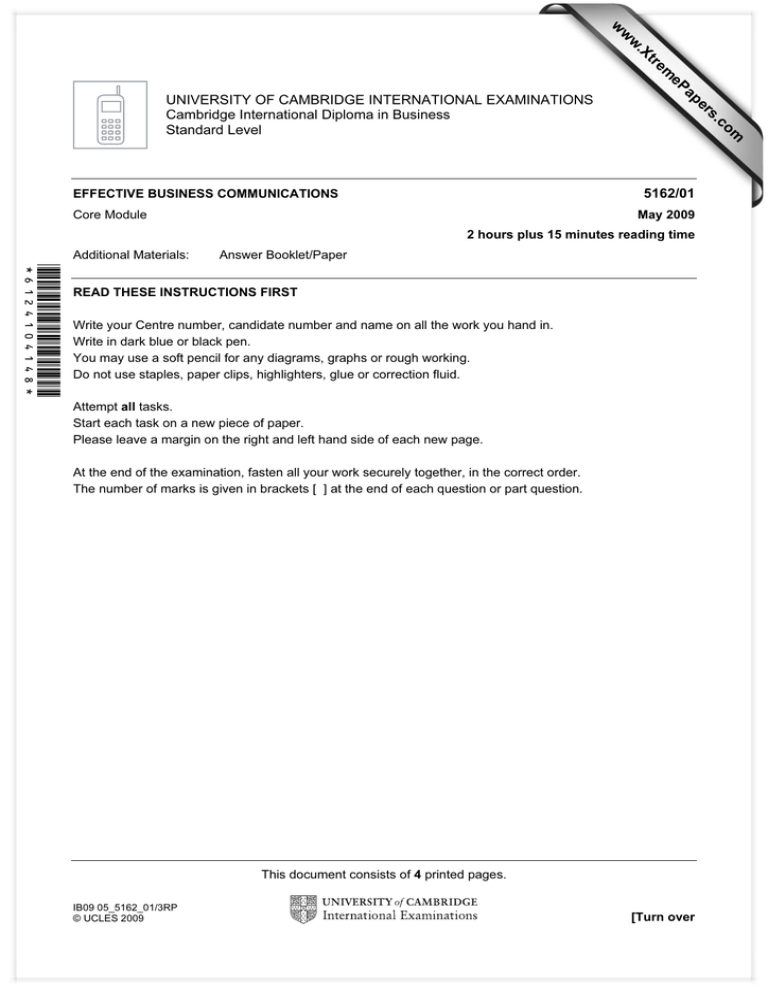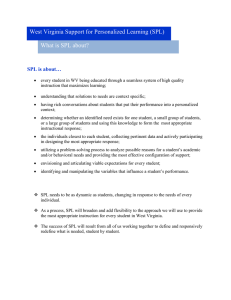www.XtremePapers.com
advertisement

w w ap eP m e tr .X w om .c s er UNIVERSITY OF CAMBRIDGE INTERNATIONAL EXAMINATIONS Cambridge International Diploma in Business Standard Level 5162/01 EFFECTIVE BUSINESS COMMUNICATIONS Core Module May 2009 2 hours plus 15 minutes reading time Additional Materials: Answer Booklet/Paper *6124104148* READ THESE INSTRUCTIONS FIRST Write your Centre number, candidate number and name on all the work you hand in. Write in dark blue or black pen. You may use a soft pencil for any diagrams, graphs or rough working. Do not use staples, paper clips, highlighters, glue or correction fluid. Attempt all tasks. Start each task on a new piece of paper. Please leave a margin on the right and left hand side of each new page. At the end of the examination, fasten all your work securely together, in the correct order. The number of marks is given in brackets [ ] at the end of each question or part question. This document consists of 4 printed pages. IB09 05_5162_01/3RP © UCLES 2009 [Turn over 2 You must read the case study below and attempt ALL the tasks which follow. (The case study is fictitious.) SUNAM PETROLEUM COMPANY Sunam Petroleum Company (SPL) is a multi-billion dollar oil producer with its Head Office in the Middle East. SPL competes with companies such as Shell, Exxon and BP and is a major player in world oil production. SPL operates in 76 countries worldwide and has a workforce of over 100,000 people, many of whom work in oil fields. The organisation is constantly under pressure from its shareholders to increase its financial 5 performance and increase its profitability. Each year SPL sets cost reduction targets, but it also expects to get increased performance at the same time. This year the Purchasing Department in particular seems to be facing the major challenge of cost reduction activity. The Vice President for Purchasing at SPL is Ken Yong. He and his Global Training Manager, Olav Yen-Ying, have been exploring ways of achieving cost reductions for the Purchasing Department. 10 There are over 2000 employees involved in purchasing and one of the key ways of improving performance would be to ensure that all purchasing staff are trained to the highest standards. Both Ken and Olav believe this could be achieved by using internationally recognised training programmes suitable for employees in the 76 countries. Ken and Olav have contacted a major training organisation called Purchasing Solutions, which is 15 well known for providing online training. Using Purchasing Solutions seems to be the best way of providing high quality training for all staff in the 76 countries where the company operates. The training would be in the English language, as this is the common business language of SPL. The Directors of SPL have finally agreed to set up online training in the form of an e-Purchasing Academy. The e-learning is designed to be used by all the staff in the Purchasing Department, 20 from junior positions to very senior managers. Purchasing Solutions would provide a system whereby personal training records would be developed, with each individual member of staff being given specifically allocated e-learning tasks which match their current job role and future development. Both Ken and Olav truly believe that effective training could bring about the improved performance required. However, such an initiative would need very careful and constant communication with all 25 participants. This presents a number of challenges as the e-learners are geographically spread worldwide. SPL is very innovative in its communications. It uses an intranet and a number of alternative methods of communication including web, video and telephone conferencing. In addition to this, SPL has a Core Team responsible for all regional communication i.e. Africa, Asia 30 Pacific, USA, Europe and the Middle East. Once the project is launched Olav will need to prepare quarterly reports on how often employees use the e-Purchasing Academy. He will need to present information on: 1. 2. 3. 4. 5. Hours of e-learning undertaken Number of training courses completed Number of training courses not completed Names of candidates who have or have not completed the course Regional usage of e-learning i.e. reporting on usage in the 76 countries You work for Olav as a Training Communications Officer. The launch date is now only two months away and he wants your help in making sure that this initiative is communicated effectively. © UCLES 2009 5162/01/M/09 35 3 You must attempt ALL of the following tasks. Where appropriate use information from the case study to support your answer. 1 Olav is keen to use as much two-way communication as possible. The training programme is complex and participating employees may have many questions. (a) Describe the following methods of communication which SPL could use when communicating about the e-Purchasing Academy. Give one benefit of each. (i) Video conferencing (ii) Telephone conferencing (iii) Seminars (iv) Team briefings [4 x 3 = 12] (b) Identify four factors that Olav should consider when selecting the most appropriate form of internal communication to promote the e-Purchasing Academy. Give a reason for each factor. [4 x 2 = 8] [Total: 20] 2 Ken and Olav have decided to organise a briefing for the Core Team. The meeting is to take place at the end of the month. (a) Write a memo to members of the Core Team, requesting them to attend a meeting to discuss the communication plan for the launch of the e-Purchasing Academy. Use the case study to assist with this memo and make up content relating to time and venue. [8] (b) SPL uses an intranet to communicate with its staff in 76 countries. (i) Explain what is meant by an intranet. [4] (ii) Identify two benefits to SPL of using the intranet to communicate about the e-Purchasing Academy. [2 x 2 = 4] (c) Identify two disadvantages of using electronic forms of communication when communicating with staff in different countries. [2 x 2 = 4] [Total: 20] 3 Olav is preparing a presentation for the meeting with the Core Team. (a) Identify what Olav will need to consider in terms of verbal and non-verbal communication when planning the presentation. [8] (b) Olav realises that team work will be essential if the Core Team are to work effectively. Explain how each of the following affects working relationships. (i) Relationships within the group [4] (ii) Size of the group [4] (iii) Group culture © UCLES 2009 [4] [Total: 20] 5162/01/M/09 [Turn over 4 4 Olav is planning to recruit a training officer to undertake measurement and monitoring of the e-Purchasing Academy. It is important that the right person is appointed to ensure its success. (a) Explain what you as the interviewer will need to plan for this type of recruitment/selection interview. [12] (b) Open and closed questions can be used in an interview. Explain what open and closed questions are. Provide one example of each, based on the case study. [2 x 4 = 8] [Total: 20] 5 Olav needs to prepare quarterly reports on how often employees use the e-Purchasing Academy. (a) Describe three types of graphical visual aid which Olav could use. Give reasons why each would be useful for presenting the relevant information. [4 x 3 = 12] (b) Give two examples of how technology could help Olav enhance the visual communications for his presentation to the Core Team. [2 x 2 = 4] (c) Olav is planning to use a Gantt chart to demonstrate the roll-out plan for the e-Purchasing Academy. Explain what a Gantt chart is and give two benefits of using it for the roll-out plan. [4] [Total: 20] Permission to reproduce items where third-party owned material protected by copyright is included has been sought and cleared where possible. Every reasonable effort has been made by the publisher (UCLES) to trace copyright holders, but if any items requiring clearance have unwittingly been included, the publisher will be pleased to make amends at the earliest possible opportunity. University of Cambridge International Examinations is part of the Cambridge Assessment Group. Cambridge Assessment is the brand name of University of Cambridge Local Examinations Syndicate (UCLES), which is itself a department of the University of Cambridge. © UCLES 2009 5162/01/M/09





